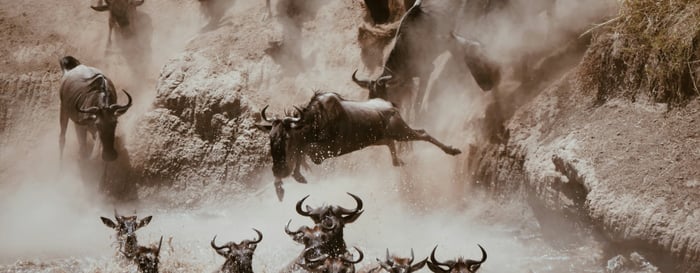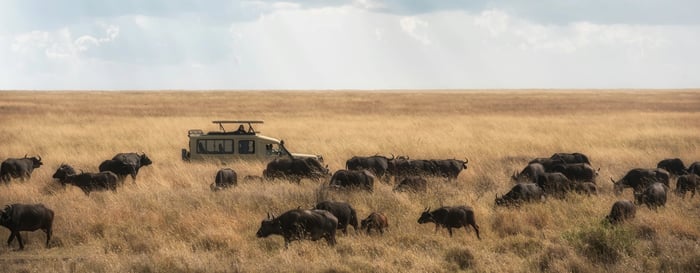It was so beautiful back then, there were animals everywhere. The Serengeti… It was my dream come true.
Why did you decide to switch from being a scientist in the forest to an activist who travels all over the world?
Why am I travelling 300 days a year around the world when I would much rather be out in the rainforest? I was at a conference in 1986 with chimpanzee researchers. It shocked all of us I think when we saw chimpanzee numbers were dropping and forests were being destroyed. At the same conference we also had discussions about the horrible ways that chimps were being treated in medical research - knowing by then that they are our closest living relatives. Chimps have emotions - happiness, sadness, fear, despair and that they can certainly feel pain. I went to that conference as a scientist and left as an activist. It’s since then that I have been on this crazy schedule around the world trying to wake people up to what’s happening.
What has been your most fulfilling day in the wild?
The most fulfilling day in the wild was when a group of chimps that had been running away from me for four months allowed me to get close and just looked at me and went on grooming. That was an amazing, amazing moment. But also seeing David Greybeard, one of the first chimps to lose his fear, seeing him making and using tools. At that time it was thought by science that only humans made and used tools. If people had bothered to go out into the forest and talk to some of the indigenous people in Africa they would have told you that of course chimpanzees make tools and use them. But back then, you know, science knows best. Scientists still think they know best and they don’t always know best, quite honestly.
It wasn’t very nice to be charged, dragged and stamped on by a high-ranking male, who then finally left me. Bashed my head on a rock, not on purpose, as he pushed me over. I thought “Oh I survived that”. Then he did it all over again and pushed me over the edge of a precipice, but luckily there were bushes that caught me. It was in about 1976/7. He did this to me and our videographer. He wasn’t trying to hurt us, he was trying to prove his dominance.

I was sat next to the new director of National Institute of Health in America, Francis Collins at a dinner, a brilliant man. He led the team that unravelled the human genome. And I just happened to meet him when he was in the job only two weeks. Of course, I mentioned chimps, because I had been struggling with that since 1986 and this was four years ago. He said Jane I don’t know anything about chimps, I’m a geneticist. [Goodall preceded to petition him and request that the NIH stop using chimps in labs]. Collins put together an investigation team of 11 people (10 NIH scientists and a member of the Jane Goodall Institute that looked at whether it was scientifically essential to use chimps in research). They spent 18 months and they investigated the research being done on some 400 chimpanzees in either NIH labs or labs sponsored by NIH. And the two questions they were told to ask were – is it beneficial to human health and is it potentially beneficial to human health? After 18 months the reply from every single investigation to both questions was no. He got a lot of comments from the scientific community – maybe it will be beneficial in the future, let’s keep some back. But he said ‘no’ and they are going to sanctuaries. They haven’t all gone yet, because we need to raise the money.
It always comes down to individuals. We tend to generalise – we see the NIH as this big institution, but it was one individual who made it happen. Probably the best day for me as an activist was when the National institute of Health in America released all chimps from medical research into sanctuaries.
Absolutely, that is my job in life and it’s not just young people. I have to target the youth because it’s important, that’s their future, but it’s also important to target the decision makers, the teachers, the parents, just the ordinary people, because we are all in this together. We all need to play our part. Every single one of us makes an impact on the planet every day. We’re in the fortunate position in countries like this [Singapore] to choose the type of decisions we want to make. So when I’m going round giving my talks almost every single one has hope somewhere in the title and so do my books - Harvest for hope, Hope for Animals and their World, Seeds of Hope...
As I travel around the world, I see places that were totally destroyed where nature has come back. You have only got to think of Nagasaki where the atomic bomb has dropped and go and see it now. It’s green and lush. And you know, even in Chernobyl the wildlife has come back. So animals on the total brink of extinction can be given another chance.
But the main reason for hope is young people. Everywhere I go there are bright, shining eyes, young people telling Dr Jane what they are doing to make this a better world. And it’s very encouraging. There’s this saying, think globally, act locally. That’s where we go wrong. If we think globally, we lose hope, because the picture is very grim, we are going through very dark times. So let’s concentrate on what’s in front of us, what’s around us and what we as an individual and as a group of individuals can do. Like clearing up litter, like removing invasive species, raising money for victims of earthquakes in other countries… Things that people choose to do to help people and the environment.
In England in the old days, people used to spend their Saturday afternoon watching a public hanging. People would take a picnic, take the kids and watch people being hung by the neck at the gallows, but we don’t do that anymore. As for hotel groups, it’s not just the hotel management, it’s the people that come to the hotel. Don’t ask for shark fin. Write a complaint. Say that the food was delicious, but I was shocked to see shark fin soup on the menu so hopefully when we do that it will soon start to change. It’s customers as well as the management. It’s education. And children are educating their parents all the time.
Probably in front of a group of government officials in North Korea (laughs). [Dr Goodall is prompted to make a chimp sound] I just said. “This is me, this is Jane.”
Do you have retirement in your plans?
What’s that?
Dr Jane Goodall, DBE, founder of the Jane Goodall Institute & UN Messenger of Peace was in Singapore for the Jane Goodall Institute Singapore's inaugural ConservAction Week.
Photographs courtesy of the Jane Goodall Institute
Mobile Migration in Tanzania
Serengeti & Northern Tanzania Ngorongoro Crater & Lake Manyara Tanzania Africa
- The beauty of the Ngorongoro Crater, a UNESCO World Heritage site
- Daily nature drives across a landscape including 25,000 animals
- Guided walks, sundowners and Maasai cultural experiences
- A hot-air balloon flight over the open savannah at sunrise
- Witnessing the wildebeest migration from Serengeti National Park
Off the beaten path in Tanzania
Nyerere National Park & Southern Tanzania Lake Tanganyika & Western Tanzania
-
African game drives in Ruaha National Park searching for elephant, giraffe, leopard, wild dog and lion
-
An early morning bird safari in Nyerere National Park
-
Explore the Great Rufiji River on a walking safari
-
Search the Mahale Mountains National Park for chimpanzees
-
Swim in ice-cold pools in the mountain waterfalls of Greystoke Mahale
Safari Highlights of Tanzania
Ngorongoro Crater & Lake Manyara Serengeti & Northern Tanzania Tanzania Africa
-
Enjoy spectacular views over the Ngorongoro Crater
-
Experience the thrill of seeing African wildlife on game drives
-
Track animals on foot with an experienced guide at Grumeti Reserve
-
Witness wildebeest crossing the river in the Serengeti National Park
-
Stay in intimate, luxury bush camps with pools and spa treatments









